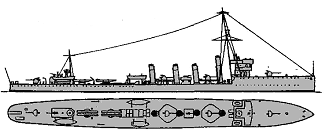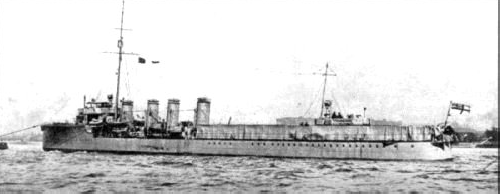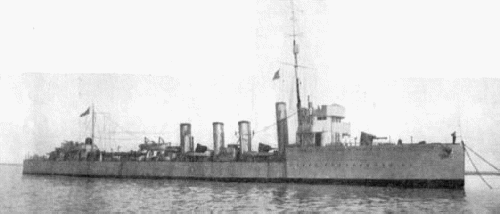
Abdiel 1916


Abdiel 1916

Gabriel 1919
| Name | No | Yard No | Builder | Laid down | Launched | Comp | Fate |
| Nimrod | H5A, H90 | Denny, Dumbarton | 10/1914 | 12.4.1915 | 8/1915 | BU 11.1926 | |
| Marksman | H96, G35, F85, G23, F66 | Hawthorn Leslie, Hebburn | 7/1914 | 28.4.1915 | 11/1915 | BU 11.1921 | |
| Kempenfelt | HA1, G10, F87, G12 | Cammell Laird, Birkenhead | 10.1914 | 1.5.1915 | 8.1915 | BU 5.1921 | |
| Lightfoot | H76, H53, G22, F78 | White, Cowes | 6/1914 | 28.5.1915 | 5/1915 | BU 5.1921 | |
| Abdiel (ex-Ithuriel) | G07, F43, F49 | Cammell Laird, Birkenhead | 5.1915 | 12.10.1915 | 3/1916 | BU 7.1936 | |
| Gabriel (ex-Abdiel) | G21, F00, F91 | Cammell Laird, Birkenhead | 1.1915 | 23.12.1915 | 7/1916 | BU 5.1921 | |
| Ithuriel (ex-Gabriel) | G32, G50, F83 | Cammell Laird, Birkenhead | 1/1915 | 8.3.1916 | 8/1916 | BU 11.1921 |
|
Displacement normal, t |
1440 |
|
Displacement full, t |
1700 |
|
Length, m |
99.0 |
|
Breadth, m |
9.68 |
|
Draught, m |
3.66 |
|
No of shafts |
3 |
|
Machinery |
Kempenfelt, Abdiel, Gabriel, Ithuriel: 3 Parsons steam turbines, 4 Yarrow boilers Lightfoot: 3 Parsons steam turbines, 4 White-Forster boilers Marksman, Nimrod: 3 Brown-Curtis steam turbines, 4 Yarrow boilers |
|
Power, h. p. |
36000 |
|
Max speed, kts |
34.5 |
|
Fuel, t |
oil 515 |
| Endurance, nm(kts) | 2500(15) |
|
Armament |
4 x 1 - 102/40 QF Mk IV, 2 x 1 - 40/39 2pdr QF Mk II, 2 x 2 - 533 TT (4) |
|
Complement |
104 |
Project history:
Experience with the Swift and the comparatively
low speed of the scout cruisers confirmed the need for a new type of flotilla
leader, based on the destroyer. A conference of the
War Staff in October 1913 proposed that a 'Tribal' class (Crusader,
Maori or
Zulu, or Swift
herself) should be given PouIsen long-range wireless (150nm
range) and have the bridge enlarged to accommodate the additional Captain (D)'s
staff. However the Controller instructed the DNC to
prepare a legend for a leader not exceeding 1800t, a
speed of 33-34kts, 4 102mm
guns and 4 'anti-airship pom-poms' etc. Accommodation would include Captain (D),
an extra Lieutenat, a WO for signal duties and 8 extra
staff. The design had machinery similar to the 'M' class. Although three were
proposed, only two were approved; one each for the 1st and 3rd DF, a scout
cruiser for the slower Acorn class in the 2nd
DF, and Swift to lead 4th DF, all forming part
of 1st Fleet. The design was approved in December 1913 and it was suggested that
their names should conform to the new initial letter of the flotilla which they
would lead, hence the names Lightfoot and
Marksman. In April 1914 tenders were put our
for two more, Kempenfelt
and Nimrod, to be built under the 1914-15
Estimates. In August 1914 the 12 1pdr out of the total
ordered for the 13 'M' class and the first two leaders were transferred
to the Army for use in France, so the design was
altered to 11.2-pdr guns instead,
but in February 1915 Vickers 2pdr pom-poms were substituted.
The four leaders were successful,
providing sufficient extra
space for the administrative and signal staff essential to the running of a
large flotilla. In November 1914 three more were ordered, but this time they
were given the names of angels in Milton's
Paradise Lost. One of them, Gabriel,
was selected in August 1915 for conversion to a minelayer but later the same
month Abdiel took her place. She was given
stowage for 80 mines, and when loaded sacrificed both
sets of TT and Nos 3 and 4 guns.
Modernizations: 9.1915, Abdiel: - 2 x 1 -
102/40, 2 x 2 - 533 TT; + rails for 80 mines
1917, Lightfoot, Nimrod: + 2 x 1 - 450 TT
1917-1918, Kempenfelt, Lightfoot, Marksman: + 1 x 1 - 76/45 20cwt QF Mk II
mid-1918, Gabriel: - 2 x 1 - 102/40, 2 x 2 - 533 TT; + rails for 60 mines
Naval service: No significant events.

Abdiel

Lightfoot
© Ivan Gogin, 2008-14